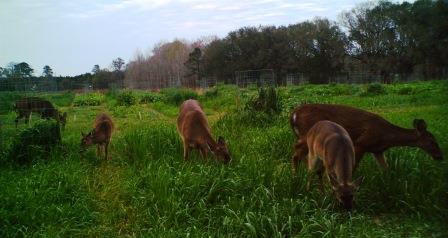Recently Jennifer Bearden, our Agriculture & Natural Resource Agent in Okaloosa County wrote a great article on “Common Wildlife Food Plot Mistakes”. The following information is a mere supplement in establishing food plots. Planting wildlife forages has become a great interest in the Panhandle. North Florida does have its challenges with sandy soils and seasonal patterns of lengthy drought and heavy rainfall. With that said, varieties developed and adapted for our growing conditions are recommended. Forage blends are greatly suggested to increase longevity and sustainability of crops that will provide nutrition for many different species.
In order to be successful and have productive wildlife plots. It is recommended that you have your plot’s soil tested and apply fertilizer and lime according to soil test recommendations. Being six weeks from optimal planting, there’s no time like the present.
Below are some suggested cool season wildlife forage crops from UF/IFAS Extension. Please see the UF/IFAS EDIS publication, “A Walk on the Wild Side: 2024 Cool-Season Forage Recommendations for Wildlife Food Plots in North Florida” for specific varieties, blends and planting information. https://edis.ifas.ufl.edu/pdffiles/AG/AG13900.pdf
Winter legumes are more productive and dependable in the heavier clay soils of northwest Florida or in sandy soils that are underlain by a clay layer than in deep upland sands or sandy flatwoods. Over seeded white clover and ryegrass can grow successfully on certain flatwoods areas in northeast Florida. Alfalfa, clovers, vetch and winter pea are options of winter legumes.
Cool-season grasses generally include ryegrass and the small grains: wheat, oats, rye, and triticale (a human-made cross of wheat and rye). These grasses provide excellent winter forage and a spring seed crop which wildlife readily utilize
Brassica and forage chicory are annual crops that are highly productive and digestible and can provide forage as quickly as 40 days after seeding, depending on the species. Forage brassica crops such as turnip, swede, rape, kale and radish can be both fall- and spring-seeded. Little is known about the adaptability of forage brassicas to Florida or their acceptability as a food source for wildlife.
For more information, contact your local county extension office.
UF/IFAS Extension is an Equal Opportunity Institution.
- More Information on Establishing Cool Season Wildlife Food Plots in the Panhandle - November 21, 2024
- Upcoming Event: Panhandle Outdoors Live at St. Joseph Bay on June 21st! - June 3, 2024
- Panhandle Outdoors Live: Woodlot Management - March 11, 2024


